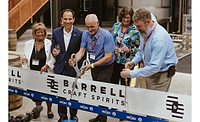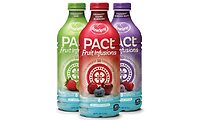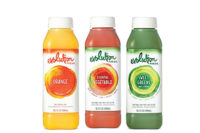![]()
American Purpac: Providing state-of-the-art juice solutions
When consumers taste a beverage, they expect it to be
the same no matter where they buy it, and that requires consistent
ingredients used across an entire bottling network. That’s no easy
task for juice-based products, which are made from highly perishable and
often inconsistent ingredients. But American Purpac Technologies LLC,
Beloit, Wis., allows juice drinks to be produced efficiently and
consistently by creating aseptically processed, bulk blended premixes for
high-acid beverages.
The company based its business on the soft drink model
in which a bottler combines syrup from a parent company with water and
sweetener, and bottles products for distribution. American Purpac is
essentially creating juice concentrates by blending perishable juice and
other ingredients to create a premix for beverage companies’ contract
packers.
With a background in beverages, ingredients and
finance, American Purpac’s management team has taken its system idea
from concept to state-of-the-art processing in a mere two years.
“As with any new idea, this is somewhat off the
beaten path,” says David Madden, president at American Purpac.
“We see ourselves providing a solution. We’re condensing a lot
of the redundant, inefficient steps in blending and consolidating them into
a single facility.”
“It’s about having one person doing all the
blending as opposed to each co-packer doing it,” Bruce Roberts, chief
marketing officer, explains further. “We want to get that consistency
of product across the country and across all the co-packers.”
The company’s plant in Beloit measures 65,000
square feet, half of which is new, state-of-the-art Class 1000 space for
aseptic processing. Nearly everything in the plant has been designed around
quality control and seamless record-keeping.
“This is a closed-system,” says Roberts.
“More and more companies are trying to get away from open systems
where you have bioterrorism and other types of issues. The plant itself is
compliant with the bioterrorism act of 2002, so we can trace product within
four hours.”
There are two and a half miles of stainless steel
pipes running through American Purpac’s plant, and 289
“ozzies”, or computerized valves that track operations.
“The computer is reading every valve, every flow
meter,” says Scott Eckman, chief executive officer. “The whole
facility is monitored constantly.”
From the moment juice enters the plant, a detailed
record is put into the plant’s computer system. Trucks pull into an
enclosed tanker bay, which is sealed and has an air evacuation system to
pull exhaust out of the room. Truck drivers download product information
and samples of the product, which are transmitted to the QA/QC department
to be tested for qualities such as color, brix and pH levels. Only after
the quality control department gives the go-ahead can the juice be pumped
to one of the plant’s four 8,000-gallon ambient holding tanks or two
8,000-gallon temperature-controlled tanks.
American Purpac is certified as a cleaning station,
which means the tankers can be cleaned at the plant and sent to their next
destination rather than traveling 40 or 50 miles to an independent cleaning
station.
Several parts of the plant are climate-controlled,
with sweeteners stored in a 90° F environment, frozen products held in
a –21° F freezer and chilled ingredients held in a
9,000-square-foot, 26° F cooler.
Juice and other ingredients are mixed in the
plant’s blending lab and sent to one of five 3,000-gallon blend
tanks, two of which serve an aseptic bulk filler, two serve an aseptic
small bag filler, and one serves the plant’s hot-fill PET and juice
cup lines. The company currently fills aseptic premix packages from 2
liters to 340 gallons.
Aseptic processing differs from traditional juice
pasteurization in that product is heated to a much higher temperature
— 195° F — for
a matter of seconds as opposed to a lower temperature for as long as 30 or 45 minutes.
a matter of seconds as opposed to a lower temperature for as long as 30 or 45 minutes.
The process creates juices that not only are
pasteurized, but they are shelf-stable without the addition of
preservatives and other ingredients.
“People are saying, ‘let’s go out
there and take some of the products that we’ve always had frozen and
filled with preservatives and artificial flavors, and get back to a really
natural product’,” says Eckman. “You can do that with
aseptics. We’ve been able to present to the industry the quality,
safety and cost savings that this technology brings.”
The entire production process is monitored from a
control room, and the plant features a full-service QA/QC lab that inspects
both raw materials and finished goods. The plant also has a clean-in-place
(CIP) system that is capable of cleaning some lines, even as the others are
still running.
In addition to premixed blends, the company does some
of its own finished product packaging, including 4-, 6- and 8-ounce
single-strength juice cups for institutional accounts, and 12- to 64-ounce
hot-fill PET bottles for short-run product development projects.
“Customers who are between a pilot lab product
development stage and full commercial production typically run into a
bottleneck. They have to go to market with what they can produce in the lab
and hope it mimics commercial production, or they have to go to a line that
runs 500 to 800 bottles per minute and that might be more product than they need,” explains Madden.
Running at 100 bottles per minute, American
Purpac’s hot-fill bottle line can be used to validate product
concepts, producing enough product for a test market in the hopes that the
customer will come back for the full product ramp-up.
American Purpac’s plant has an onsite warehouse
that is used to store raw materials and some finished product. The company
holds all finished goods for five to seven days before shipping as a
quality control measure, but it has a 40,000-square-foot offsite warehouse
where excess packaging and other finished goods are stored.
American Purpac has created a unique business, and the company
already is preparing for expansion. It hopes to set up a West Coast plant in
the near future, using the Beloit operation as blueprint. The plan is to have
operations close to the main fruit-growing regions of the country.
“This plant, our first plant, is a model for future plants,” says John Saladino, chief financial officer. “We will take our footprint from this facility and move it to the West Coast. This business model is basic and will go across the nation.”
Loyal to Beloit
American Purpac can serve 26 percent of the total U.S. population
within 10 hours of its plant in Beloit, Wis., but that’s not the only
reason it chose the city on the border of Wisconsin and Illinois for its headquarters.
The company’s financial partner, Ken Hendricks, is particularly loyal
to the area. He started his own building supply business in Beloit 20 years
ago, and since then has been dedicated to bringing more jobs and growth to
the area.
“He has had an ongoing commitment to the community and
to Beloit,” says David Madden, president at American Purpac. “His
whole drive these days is to bring employment to the Beloit/Janesville area.
Without his vision and support, we wouldn’t be here.”






